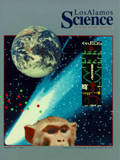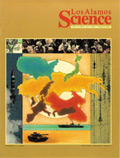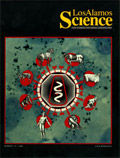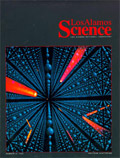Contact
|
Los Alamos Science Archive
Issue: 1-5 | 6-10 | 11-15 | 16-20
| 21-25 | 26-30
<< Previous Page | Next Page >>
| Unsolved Problems in the Science of Life: Proceedings of the Fellows Colloquium July '86 |
 |
In a conference sponsored by the Laboratory Fellows on the evolution and mysteries of intelligent life: George Wald, Nobel Laureate in physiology, spoke about the nature of consciousness; David Hubel, also a Nobel Laureate in physiology, discussed his work on the neural circuits responsible for the perception of form, movement, and color; paleontologist Jack Sepkoski talked of periodic extinctions on Earth and their role in the evolution of new life forms; and physicist Frank Drake outlined the logic for the existence of intelligent life elsewhere in the universe. A roundtable with the participants followed the formal presentations.
Go to Table of Contents |
| National Security Issue |
 |
This volume, published prior to the end of the Cold War, reports on a national security conference aimed at predicting the future of nuclear weapons. While the participants did not predict the demise of the Soviet Union, they did foresee the more limited role for nuclear weapons in the US military posture, the increased emphasis on conventional warfare, and the rise of Japan and China. The increased reliance on conventional weapons predicted in this volume became explicit US policy in 2002 following the Nuclear Posture Review.
Go to Table of Contents |
| AIDS Research |
 |
In the late 1980's, before it was known that all people are vulnerable to HIV/AIDS, various members of LANL's Theoretical Division began to research basic questions about the growth of the AIDS epidemic and the evolutionary origins of the deadly virus. They developed a risk-based model outlining the growth of the epidemic, who is at risk, and what intervention strategies would be most effective. To trace the evolution of the virus and the rate at which it was mutating, LANL scientists also established a DNA Sequence Database for HIV. This volume discusses these topics and also includes a tutorial, "AIDS Viruses of Animals and Man," which explains how retroviruses, known as lentiviruses, act as parasites of the immune system and discusses the prospects for an HIV vaccine. Since publication of the volume, research on the mutation of the HIV virus and the development of treatment strategies has continued at LANL (see article in 60th anniversary volume).
Go to Table of Contents |
| Neutron Scattering |
 |
Neutrons have been used to probe the structure of materials since nuclear reactors became a good source of neutrons. In 1975, LANL became a leader in the field when it began the user program at LANSCE, an intense pulsed spallation neutron source, powered by an 800 MeV linear accelerator. The field of neutron scattering was still relatively young, and this volume sought to introduce the field to a wider audience. A primer explains the techniques and applications of neutron scattering, while specialized, pedagogical articles explain how neutron scattering is used to deduce protein and crystal structure and can also be used to study catalytic systems and superfluid helium. The closing article is a tutorial on Bayesian data analysis and its application to neutron scattering data.
Go to Table of Contents |
| The Human Genome Project |
 |
The human genome, the DNA content in each of our cells, presents us with a vast frontier containing answers to many questions about how we evolved, how we are related to other living things, and how we differ from one another. The Human Genome Project is opening up that territory to our understanding. LANL scientists were instrumental in getting the DOE involved in this project and in this volume present an introduction to the tools of genetics and molecular biology and to the philosophy and early accomplishments of the Project. At the time the volume was written, scientists and the public were anticipating the new genetic knowledge while physicians, lawyers, social scientists, and philosophers were anticipating the impact of that information on our institutions, our health care, and our individual lives. As the cover illustration suggests, the Human Genome Project is ushering in a future in which we are more aware of both our human potential and limitation.
Go to Table of Contents |
<< Previous Page | Next Page >>
Issue: 1-5 | 6-10 | 11-15 | 16-20
| 21-25 | 26-30
|
Latest Issue
Recent Issues
|
